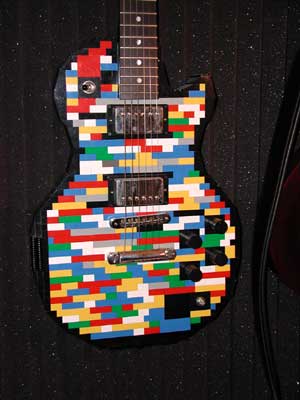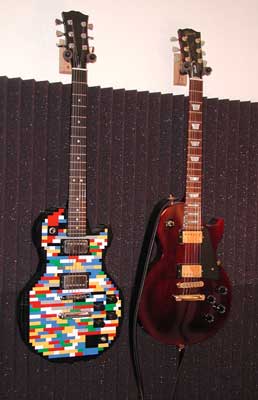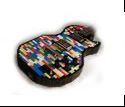Get the Tee Shirt!
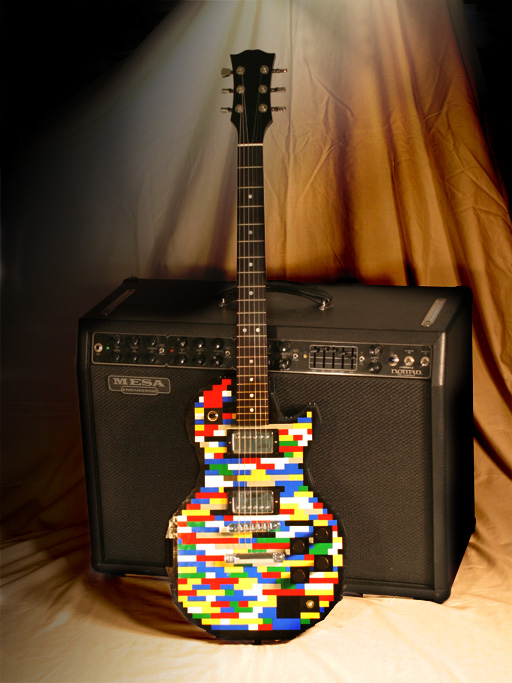
Being a musician and an engineer, I decided a long time ago that I wanted to build an electric guitar. Actually, I want to build a few - the first one is to get one under my belt and learn from. The second one will be more a work of artistic expression, and the third (if I ever get there) is a silly idea for a good conversation piece.
I decided to take the plunge in 2001
after a conversation with a friend at the NAMM convention. My criteria
for the first guitar was simple: it needed to be easy to make, yet
somehow unique. I considered all sorts of things, including just a
block of wood, pipe, or random junk screwed together. Then the flash
came: LEGO!
I built the first draft in late
January of 2001 and finished it late summer. The bottom line is it's
very cool looking, plays okay and has some interesting flaws that I
would fix if I were every crazy enough to do it again. Here are a
couple pictures of the finished piece (linked to higher resolution
pictures).
Concept
Very simple: Build a fully functional, playable electric guitar with a body out of Lego. Don't worry if it isn't a perfect work of art. Learn a lot and have a lot of fun. Come out of it much smarter, and play it on stage.Design
I'm a Les Paul fan. I love the shape of the guitar and I love the feel of it. I hate the weight.Body
I decided to use the basic design of my Gibson Les Paul Studio for the body, but to use a standard bolt-on neck.
The body was far and away the biggest challange because it was the part I built from scratch. I didn't know the true structural integrity of Lego blocks, other than I knowing I would have to glue them together at a minimum (Krazy Glue seems to do the best job on the blocks). I considered adding some additional strength to the body by embedding wood or aluminium rods. When tuned up, the strings on an electric guitar pull with about 180 lbs. of force - just picture an adult hanging from the neck and that's about how much force the neck and body are under. Despite that, I decided to be a Lego purist and only use Lego for the body.Neck
The design process for getting the body shape figured out took a few weeks and a lot of building. Here is more detail about the process I went through and the tools I used.
I tested a few types of glue and found Krazy Glue to be the best. I also considered using epoxy, but it was not as strong as Krazy Glue and much harder to work with. I tested the strength of Krazy Glue and epoxy to compare them, and also to get some level of confidence that the body would be strong enough to manage the stress of the strings without exploding. My very non-scientific process determined that one "pip" of Krazy Glued Lego could hold 18 pounds, while the sloppier and smellier epoxy version could only hold about 16 pounds. Follow this link to see how I proved this with dog food.I built the body three or four different times, each time adding something new. Each new body took dozens of hours to build, and involved a process of scavenging the old body for the new one. The stages were:
1. One brick thick proof of concept to see if I could build a shape that looked like a guitar.
2. Full thickness with as many proper slopes as I owned in place. Large area left open for where the pickups would go.
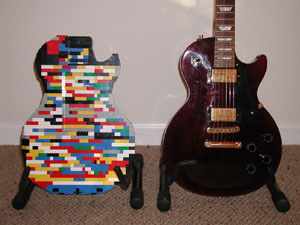 3. Final version with proper size holes for pickups, and channels for wiring. Also figured out where knobs and electronics would go. Some missing pieces that had to be special ordered from BrickBay.
3. Final version with proper size holes for pickups, and channels for wiring. Also figured out where knobs and electronics would go. Some missing pieces that had to be special ordered from BrickBay.
4. Final final with all pieces in place.Once assembled, the pieces were glued together. Again, there was a lot to learn here. Lessons and gluing technique can be found here. It took at least 20 hours just to glue the body.
Since the body is modeled on a Gibson Les Paul, I wanted to be true to the design and use a Gibson style neck. Someday I might try building a neck, but not on my first guitar. I shopped around for suppliers and settled on Warmoth, I liked their attention to detail and the fact they cater only to guitar builders.From an aesthetic standpoint, the neck needed to blend as close as possible with the body, so paint rather than wood was my prefered finish. Black is my preferred color, making black paint and an ebony fretboard the obvious choice for the finish. I thought a lot about the inlays, and decided that basic round plastic dots actually go best with the concept of the guitar.
Here are the specs of the neck I ordered. The only thing I would change is the Back Shape. It is way fatter than my Les Paul and not very comfortable.
| Neck type | 13degree angled peghead | Same as a Gibson. |
| Peghead shape | Gibson LP | Same as a Gibson. |
| Neck wood | Maple | Brighter tone than mohagany, cheaper and will be painted. |
| Fingerboard | Ebony | Feels good, and it's black. |
| Nut width | 1 11/16" | Not too thin, not too fat, just right. |
| Back shape | Fat | Warmoth said this would feel the most like my Les Paul. |
| Fret wire size | 6105 | "Typical." I currently have no opinion about fretwire sizes. |
| Keyhole size | Drilled for Schaller/Grover tuners | Hope I made the right decision. |
| Finish | Black paint | It's a plastic guitar. Wood would clash. |
| Inlay | Standard - which are plastic dots | Perfect for a legotar. |
I used a Gibson style Tune-O-Matic bridge. This was a true pain in setting the guitar up, as the neck has to be angled way back to make up for the height of the bridge. This also means the pickups have to be raised really high to get close to the strings.Electronics - Pickups and Switches
I put Seymour Duncan pickups in it, and they rock. I wired it with a switch on the volume knob so that if you pull it out it shorts the pickups to get more of a Fender sound. There is a ton of control over the tone.
Links
Guitar Parts
- Pickups: need I say more than Seymour? For piezo/synth pickups: LRBaggs and RMC Pickups.
- Warmoth - Necks and other parts.
- The Lego site has a page of Lego graph paper you can print out to design on.
- Need odd bricks? Brickbay is the place to get them.
- Bulk bricks are best gotten at Toys 'R Us or Target. Big blue buckets with 1200 pieces are $19.99.
- Gelb Music - my local great guitar store.
- The best book I've found: Make Your Own Electric Guitar, Second Edition. Melvyn Hiscock. NBS Publications. 1998.
Lego
Resources
The Tee Shirt
About Me
I play for fun, not professionally. I play in a cover band with four of my friends. I would say I'm one of the top five best players in the band, but I do have the coolest guitar. Other information about me is available at www.anirama.com.If you'd like any additional information about this experience you can email me at carl@anirama.com.
